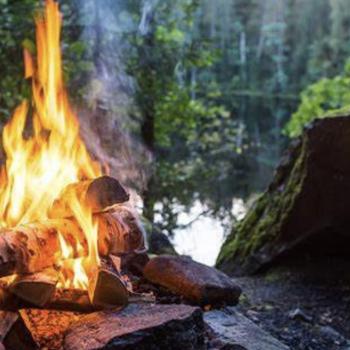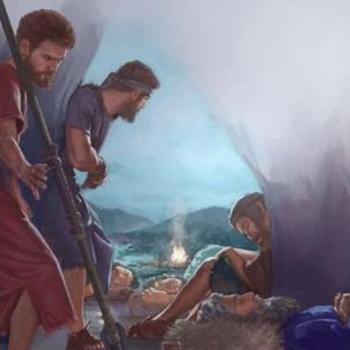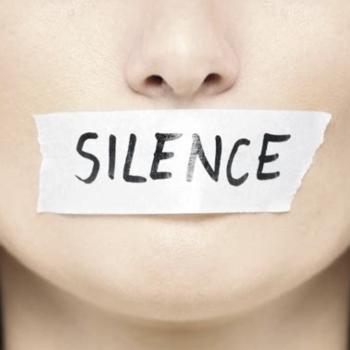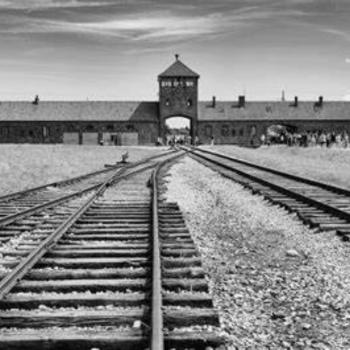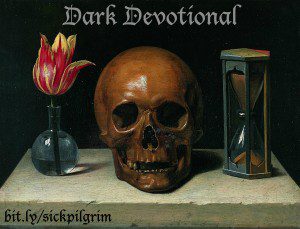
And Joseph took the body and wrapped it in a clean linen cloth, and laid it in his own new tomb, which he had hewn out in the rock; and he rolled a large stone against the entrance of the tomb and went away. And Mary Magdalene was there, and the other Mary, sitting opposite the grave. (Matthew 27:59b-61)
The two Marys, sitting opposite the grave. In some translations it says that this was a garden, so when I picture this, I imagine two women on a park bench surrounded by flora. Mark tells us the women were looking on to see where Jesus is laid. Luke writes that the women returned and prepared spices and perfumes. Matthew is the one who tells us the women are just sitting there.
Maybe from his perspective, it appeared as if they were doing nothing. But they weren’t. They were probably crumpled, holding one another as they wept. They sat because there was nothing else they could do. They didn’t have the strength to stand, to walk bravely home, together, alone, while Jesus’s tomb disappeared in the distance behind them.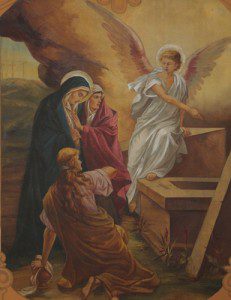
They definitely weren’t waiting, expectantly, for a front-row seat to the resurrection. They were waiting there to finish the burial ceremony before the Sabbath passed.
Jesus spent hundreds of years preparing his followers for his death. In prophecy and parable, he told them. He warned them. But no words or stories or scriptures prepared them for this. They’d given years of their lives to this man. He was the hope of the world. And He died. Was buried. He betrayed them by leaving. Their hearts went dark. It was over.
I can’t leave this image behind–the two women sitting, paralyzed by their grief, with no room in their hearts for hope. It’s too familiar to me.
I’ve lived for months at a time, years even, sitting outside the tomb. My life has come crashing down on me like Atlantic Ocean waves, the deadly rip current pulling me under as I thrashed and panicked, thinking, this is it. This is the end. Wishing that it was, because there was no rescue for me.
I spent years struggling against a darkness that threatened to consume me, asking God, “Where are you?” “What are you doing?” Praying, “You promised me that all things worked together for good, but this? This is too much.” I was crumpled outside the tomb, grieving, weary of the threat of continued living in a pain-wracked, sin-sick world.
All of us have felt that ache of emptiness or loneliness or lostness that forces us to ask, “Why are you not here?” For some of us, it’s long years of surviving abuse, living every day with the damage done. For others, it’s an addiction, secret and shameful, that leaves us feeling like we’ll never be free. The death of a friend, a parent, a child. Job loss. Financial hardship. Failure. Marriages on the brink, infidelity, separation, and divorce. Children who live in your home and yet feel lost to you. The ravages of chronic illness. The suffocating shadow of depression.
How many of us here are living, suspended, in this state of waiting?
None of us plan on sitting outside a tomb, believing our story is over and there will be no happy ending. But the tomb has to be there. It’s the quintessential plot device. And we have to spend some time sitting outside of it. It’s where repentance finds us. Where we finally, reluctantly reveal our brokenness. It’s where healing happens. It’s the place where waiting and wisdom collide.
Without the tomb, none of us is rescued. Without the tomb, the story is incomplete and worthless. Without the tomb, there is no place or reason for resurrection. Life doesn’t end at the tomb, or even inside the tomb. The tomb is the pinnacle of the most unlikely of fantasy stories—a man who comes back from the dead because he wants children to know that they were worth dying for, and even more, worth defeating death for.
The tomb is a gift that breaks our hearts open wide enough that only the resurrection can heal them.
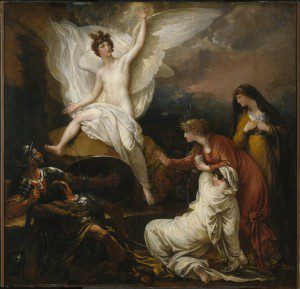 J. R. R. Tolkien created a literary term for this: “eucatastrophe,” from the Greek meaning good destruction. Destruction with a purpose, a meaning, that brings about an eventual good. Here’s how he describes it:
J. R. R. Tolkien created a literary term for this: “eucatastrophe,” from the Greek meaning good destruction. Destruction with a purpose, a meaning, that brings about an eventual good. Here’s how he describes it:
“I coined the word ‘eucatastrophe’: the sudden happy turn in a story which pierces you with a joy that brings tears. And I was there led to the view that it produces its peculiar effect because it is a sudden glimpse of Truth. I concluded by saying that the Resurrection was the greatest ‘eucatastrophe’ possible in the greatest Fairy Story.”
In his essay, “On Fairy-Stories,” Tolkien describes eucatastrophe further:
“But the ‘consolation’ of fairy-tales has another aspect . . . Far more important is the Consolation of the Happy Ending. . . . The consolation of fairy-stories, the joy of the happy ending: or more correctly of the good catastrophe. It does not deny the existence of dyscatastrophe, of sorrow and failure: the possibility of these is necessary to the joy of deliverance; it denies universal final defeat. It is the mark of a good fairy-story.”
Tolkien’s eucatastrophe is at the heart of the Gospel story, and Jesus gives his followers a rare opportunity to experience the “sudden and miraculous grace” of prophecy fulfilled by the Son of God. He himself is the good that comes from the catastrophe. And we have the rare opportunity of living in the aftermath of that good destruction, of living in this grace that is permanent and unchanging, personal and eternal, a story we have been written into and that has been dedicated to us, for even though we ourselves experience weeping and mourning in this veil of tears, He has overcome the world for us, and our joy will be made complete.
https://www.youtube.com/watch?v=wfhBHu6yFQAGo on ahead and go home
Go on ahead and go home
The spirits of the dead will meet you up ahead
You won’t be alone …
In the deep of the night,
By the river so still, where sorrows come to heal
and wrongs are made right
Down in the deep of the night,
On a creaking porch swing, the ancient ones sing
“everything is alright”
–Iris DeMent


